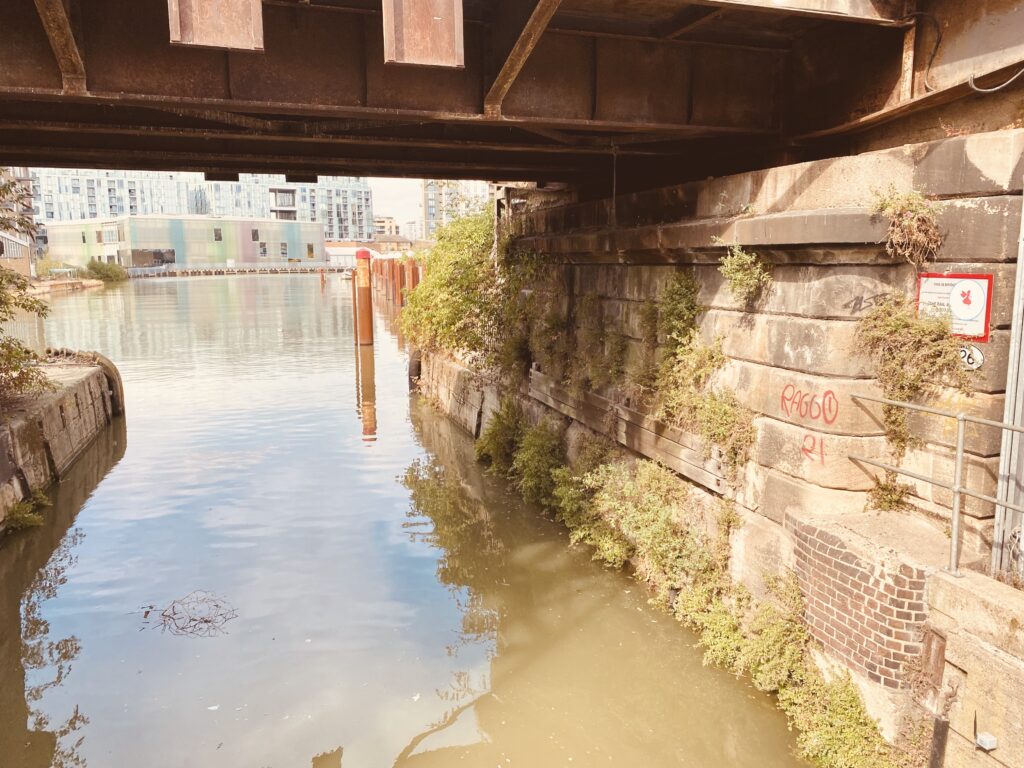On Sunday, I was ambling through the backstreets and alleys of Deptford, an area of south east London near where I live. Deptford’s backstreets are the kind of geography where they shoot a lot of films, tv shows and adverts because it’s all canals, ex-industrial docklands and railway bridges, now heavily rendered with graffiti and posters.
I was coming down a footbridge over one of the criss-crossing canals when I stepped on a heavily-worn, stencilled hashtag with an audio symbol and a QR code next to it. I can’t remember the exact wording of the hashtag, should have photographed it really, or even tried the QR code, but I was late to get somewhere. It was something like ‘#forgottenhistories’ or something.
It was immediately clear that this was the remnant of some long-dead-and-forgotten augmented reality audio tour of the local area. All of a sudden, looking around at the layers of graffiti, posters and urban detritus I could almost feel like thin skeins, floating just above the surface of the hot tarmac and brushing up against the brick walls, the ghosts of all the dead and forgotten AR histories, geo-fenced audio tours, digital tours and meta-maps around me.

New Visions of the Future
Bit of a rush this morning to write this out, I only got the render done last night but I am trying to stay on track.
I picked up on this piece from Creative Destruction – Wakanda: A Hopeful Vision Of The Future. With the new Black Panther movie coming out (which will probably be amazing) there’s a renewed fascination with the fictional nation/city of Wakanda as there was with the release of the first film in 2018. The design of the fictional city thrust Afrofuturist aesthetics further into the popular conscience and presented a powerful imaginary for how cities could be built based around community, without cars and in harmony with the ecosystems around them.
But these properties are largely aesthetic and often when wistful posts and newsletters are written about the fictional city they miss the critical context of it. (Sorry to be a downer, but it is my thing.) Wakanda is still very much viewed through colonial eyes; the story of its existence is narrativised in extractivist terms; it’s all about the vibranium, baby. Vibranium is a fictional super-metal with rare physical properties making it useful for building, well, mostly weapons. Vibranium is what keeps Wakanda safe through defence technology, it’s what gives it political weight through trade agreements and it’s what gives it a socio-political identity in the Marvel Universe. It’s implied that the only reason Wakanda has not been destroyed or colonised is because of the vibranium. Wakanda is not granted an almost utopian existence by the global stage on it’s own terms, it’s a political bargain for a rare resource.
The vibranium is used as the basis of the technology of Wakanda which seems decades ahead of the rest of the world. But even this notion of ‘aheadness’ is used as the narrative crutch to tell the audience that Waknda is a Good Place. Wakanda is better because it has technologies that we as the audience imagine to be futuristic and desirable; holograms, flying cars, etc. etc. The creators of Wakanda are sort of forced to position it as advanced and utopian in very Western terms in order to make it digestible to the audience. I wonder what a Wakanda that wasn’t posited on the extraction and trade of a rare metal and ‘advanced’ technology would look like? How might the aesthetics be different? Or is it so unimaginable that it would have survived colonisation that it must be dismissed?
I don’t know if the creators could really have done it significantly differently and still made it the enormous success it was. And, like i said, it’s been great to see it accelerate Afrofuturism into more people’s homes and eyeballs. It’s just important that designers couch hysteria about how cool something looks and how much it challenges an aesthetic with the caveat of the context in which that world is allowed to exist.
Recent
I was on the Near Future Laboratory Podcast with Julian last week. Well, we recorded it about two weeks ago and he rapidly turned out the edited version. We talked about design and futures and my journey from academia back to industry and then a useful speculation about what a crack existential crisis design team might be.
Short Stuff
- Intense and numbers heavy breakdown of the real financial cost of car ownership.
- Alice Bucknell and David McLeavy (formerly of Humber Street Gallery) in conversation about speculation, world-building and video games.
- Video games about climate change.
- Stuart Candy’s project about de-hyping (my terms) the way that the media talks about the future.
- Thanks Matt for linking me up with the full Noahpinion on the US climate deal that questions why climate economists continue to push carbon tax when subsidies for renewables (as in the deal) work a lot better at incentivising change. I mean it makes sense, right? If you’re making a bunch of money off fossil fuels but the tax goes up you’ll just pay it or find a way to avoid it. But if you suddenly make renewables more profitable? Well, as I keep saying, get to people on their terms.
Ok, love you, speak next week.